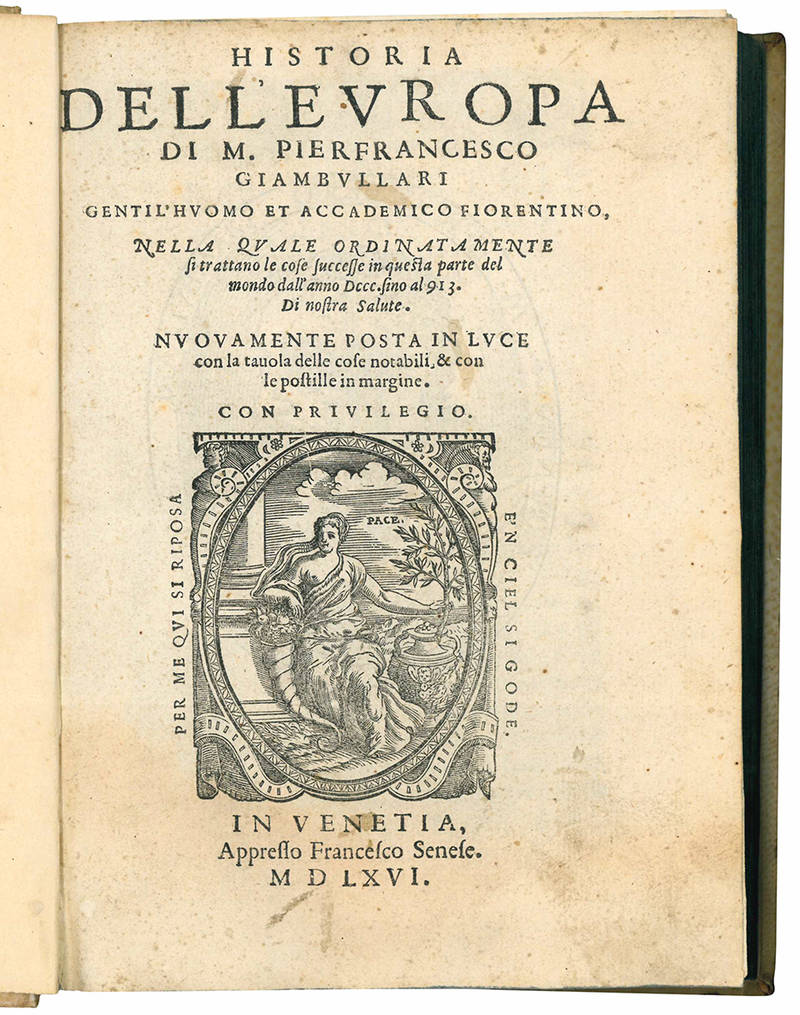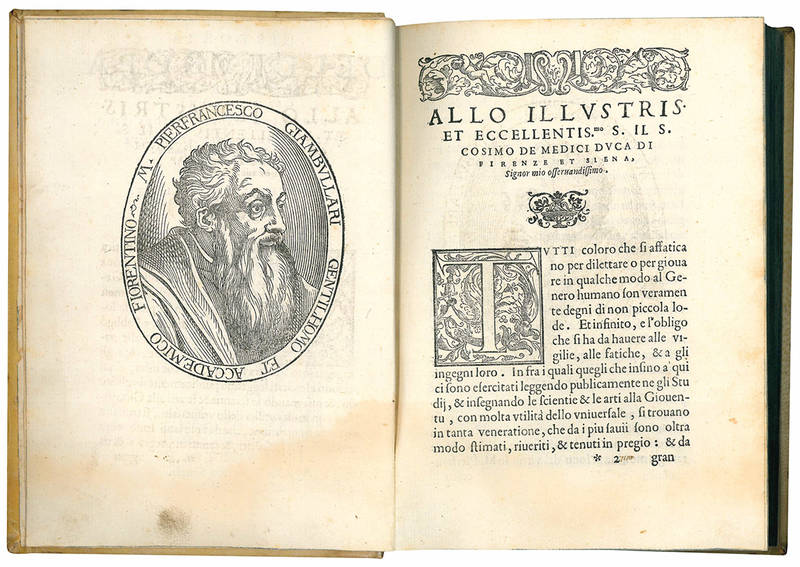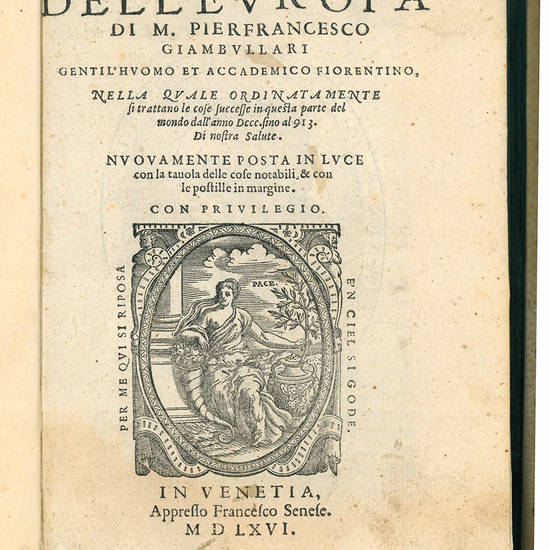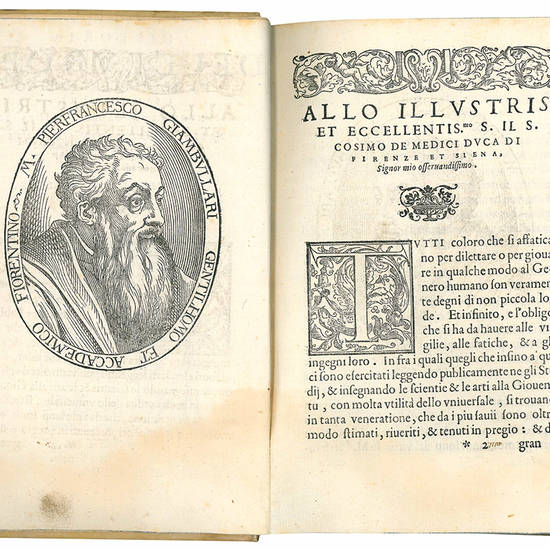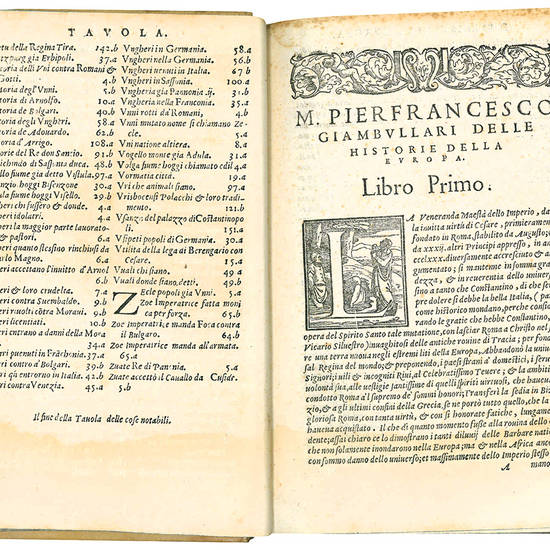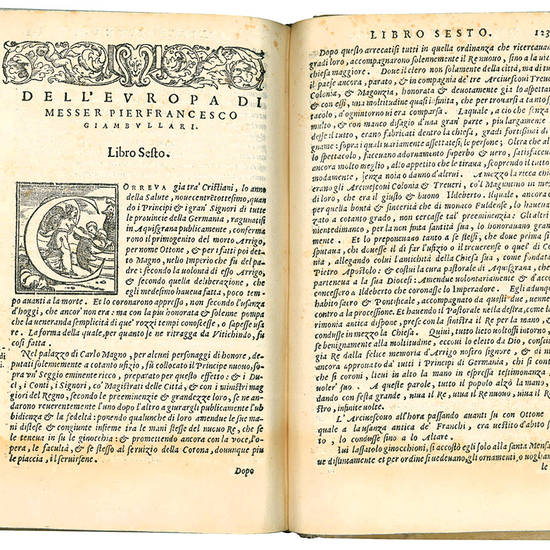Historia dell'Europa di M. Pierfrancesco Giambullari gentil'huomo et accademico fiorentino, nella quale ordinatamente si trattano le cose successe in questa parte del mondo dall'anno Dccc fino al 913 di nostra salute. Nuovamente posta in luce con la tavola delle cose notabili, & con le postille in margine
Autore: GIAMBULLARI, Pier Francesco (1495-1555)
Tipografo: Francesco de Franceschi
Dati tipografici: Venezia, 1566
“THE FIRST WORK IN ANY MODERN LANGUAGE BEARING THE TITLE HISTORY OF EUROPE” (DIONISOTTI)
4to (203x145 mm). [16], 166 leaves. With errors in numbering. Collation: *-****4 A-Z4 Aa-Ss4 Tt2. Woodcut initials and headpieces. Woodcut author's portrait on title-page verso. Printer's device on the title-page. Italic type. 18th-century vellum over boards, lettering piece on spine, blue edges. Bookplate of Count Jacopo Manzoni on the front pastedown. Title page slightly soiled, water stain to the lower margin of the entire volume, some foxing and staining.
First edition (the most common issue without thewoodcut border on the title-page), published posthumously by Cosimo Bartoli (1503-1572), who also signed the dedication to Cosimo I de' Medici and added at the end the oration he publicly read at the funeral of his life-long friend. The oration is very important for it provides the bulk of relevant biographical information on Giambullari.
This history of Europe, left unfinished for the author's death, is considered as the first general history written in Italian. In the author's intentions, it should have covered the period 887-1200, but remained unfinished at the year 947 (not 913 as stated on the title-page). Divided into seven books, it draws on over seventy historical and geographical sources from the Middles Ages and the Renaissance, but relies mainly on the 10th-century Italian historian Liutprand.
“Despite the limitations of Giambullari's history, limitations due in large part to its literary, humanistic approach, it is a remarkable work in many ways, not least in its ambitious scope, dealing as it does with events in Western and Eastern Europe and in Eastern Mediterranean in a period of relative obscurity. Dionisotti claimed it as ‘the first work in any modern language bearing the title History of Europe', and Bartoli seems to have been conscious of the novelty, praising his friend for having filled a gap in contemporary historical writing and, at the same time, for having made a vernacular synthesis of the Latin works of obscure and sometimes relatively inaccessible authors. Despite his expectation of a good reception for the Historia from his contemporaries, the work was in fact to have its most enthusiastic readership four centuries later, if the nineteen editions and reprints that appeared between 1818 and 1910 are anything to go by” (J. Bryce, Cosimo Bartoli, Geneva, 1983, pp. 235-236).
Pier Francesco Giambullari received an excellent humanistic education that included instruction in Hebrew and Greek as well as in Latin. At the age of sixteen he became the secretary of Alfonsina Orsini, widow of Piero de' Medici. While very young he took the holy orders, which made it possible for him later to be given a valued ecclesiastical post at San Lorenzo, the Medici family church. By 1539, despite a lack of published literary accomplishments, he was already well known and appreciated in the Florentine scholarly and literary world. In 1540 he became an early member of the Accademia degli Umidi and in the next year a founding member of the Accademia Fiorentina. The academy published in 1547 a volume of public lectures on Dante, of which two are by Giambullari. In 1551, under the Academy's auspices, he published a sort of Tuscan grammar, Della lingua che si parla e si scrive in Firenze, together with the Ragionamento sopra la difficoltà di metter in regole la nostra lingua,which earned him the title of ‘Reformer of the Language' (F. Pignatti, Giambullari, Pierfrancesco, in: “Dizionario Biografico degli Italiani”, LIV, 2000, s.v.).
Edit 16, CNCE20914; B. Gamba, Serie dei testi di lingua, Venice, 1839, no. 517; L. Razzolini & A. Bacchi della Lega, Bibliografia dei testi di lingua a stampa citati dagli Accademici della Crusca, Bologna, 1890, no. 165; M. Parenti, Prime edizioni italiane, Milan, 1948, p. 259.
[11062]

